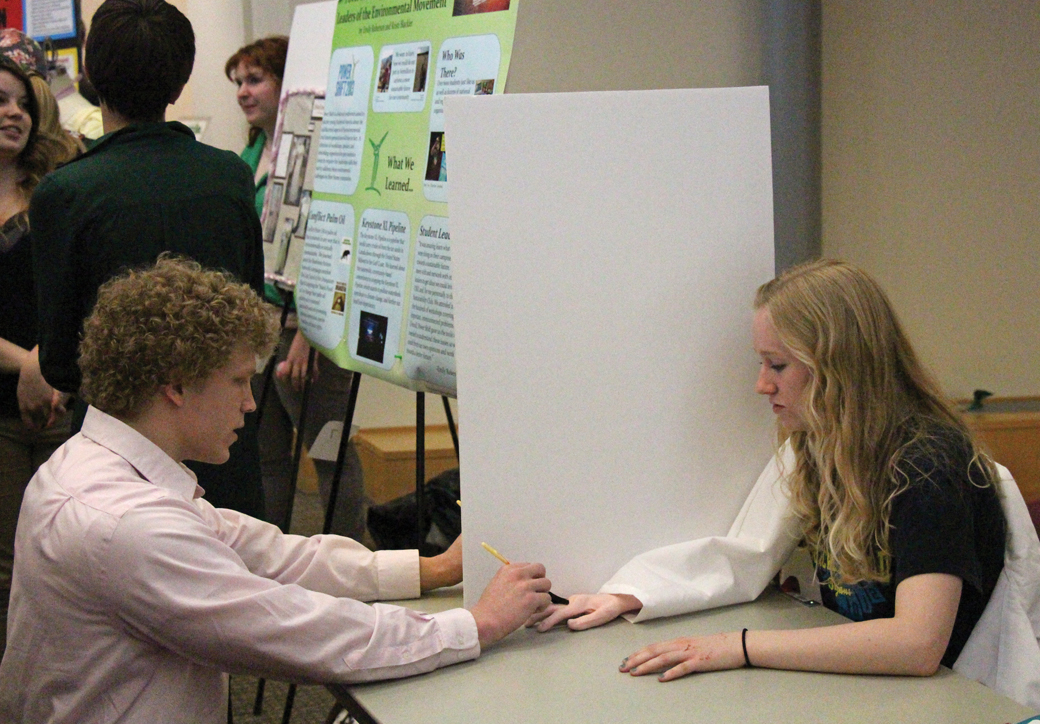
Students showcase research, knowledge at IdeaFest
April 8 brought undergraduate and graduate students of various disciplines together for the first day of IdeaFest 2014.
The annual event allows students to display their research, creativity and academic engagement through oral and poster presentations, live performances, readings and exhibits.
Poster session 1 of IdeaFest occurred from 1:30–3 p.m. Tuesday.
Graduate student Michelle While collaborated with Chris Chiller and Angela Alanson Chiller on a project.
Their presentation, called “Low Background Assays at Sanford Underground Research Facility,” involved a low-background counter stored at almost a mile underground to count radiation at the Homestake mine in Lead.
“We ended up with a factor of 10 improvement on sensitivity which makes this detector one of the most sensitive in the world,” While said. “We’re the first and only ones who have ever done it.”
The primary use of the detector is for rare events, Ward said. Copper and lead bricks were placed around the detector to stop neutrons from getting into it and to stop any radiation from occurring.
Fifth-year Ethan Domke presented “Portraiture: A Contemporary Exploration of Traditional Techniques and Methodologies.”
It featured photos of his painted portraits in which traditional techniques done in artistic salon academies were utilized. Figures in the works of art were rendered and then blended with contemporary design aesthetic.
“In person they look like they’re alive — they’re glowing — and that’s what the old masters used to do when they painted figures,” Domke said.
The paintings, in actuality, were each 24 by 32 inches and took between 200 and 250 hours to complete. He said he started on the project at the beginning of the academic year and has enjoyed the road to presenting at IdeaFest.
“I really enjoy the challenge of trying to learn how to paint figure as close to life as possible,” Domke said. “That’s kind of been like the whole goal of my artistic career and learning here at USD. It’s nice to finally get there.”
He said his paintings will be on display in the John A. Day Gallery April 21-25 for his senior show. Once he is finished with all 10 of his pieces and graduates with his Bachelor of Fine Arts and painting emphasis, he plans to apply for graduate school.
Senior Jake Johnson is a major in biology and did a presentation titled, “Myostatin Expression and the Regulation of Muscle and Heart Size in Migratory Passerine Birds.” He performed research on myostatin, a gene which regulates muscle growth in three different bird species in the Vermillion area.
Results from the year of research were analyzed, and he found the gene was involved in the muscle mass increases in one species with the possibility the other two had a different mechanism assisting in the muscle growth.
He said he became involved with IdeaFest through his boss David Swanson and the class environmental physiology.
Chair of the IdeaFest planning committee Brian Burrell said the event is a chance for students to learn and excel in a different way than usual.
“The whole benefit of doing research or whatever kind of scholarship you’re doing, is it’s a greater, more in-depth educational experience than it is just sitting in a class,” Burrell said.
He said there are set to be 224 presenters both days with a total of about 400 people helping with the projects and research, each who have benefited from the event.
“It’s a great way to learn more about a field that you’re interested in. It’s a great way to learn a little bit more about yourself,” Burrell said.
Senior Sara Mayer is studying speech pathology and did a two-year study titled “Utilizing an Electronic Assessment to Investigate Developmental Speech Patterns in Children with Visual Impairments,” with assistance from graduate student Allie Burchill.
“(The goal was) to be able to do more research with children with vision impairments because there isn’t a lot of research out there for these students,” Mayer said.
They worked on the development of an auditory assessment of articulation and phrenology — seeing how students pronounce the sounds in words — to perform research on a group of 24 children with visual impairments compared with those who do not have visual impairments.
They found there was a strong correlation in their assessment and in the Goldman Fristoe Test of Articulation already in place.
Following the day’s events, the night’s keynote address, “Making Next-Generation Biofuel Systems Work,” was given by Richard Sayre from Los Alamos National Laboratory, New Mexico Consortium.
He discussed the advantages and constraints of biofuels as an alternative to fossil fuels and the best sources for these. Sayre said corn may be an option for a source but not the only one as algae was found to produce at a rapid rate; it would depend on what is most ideal for the environment in which living.
“We’re trying to accelerate a process that took millions of years and do it in a day,” Sayre said.
He said biofuels have contributed to a 24 percent reduction in greenhouse emissions in the United States and researchers are working on finding a way to make biofuels profitable and reduce the harvesting costs.
Other events included in the day were oral sessions, a mock trial presentation, ‘politics of the vampire genre’ presentation, yote floats by IdeaFest members and a student presenter and faculty mentor reception.
Events will continue today starting with the fourth oral session at 9 a.m. and ending with the keynote address by Ellen Gustafson at 7 p.m.
IdeaFest is held in the Muenster University Center and is available to the general public as well as students.
Photo: Non-traditional first-year Cody Reed demonstrates his group’s research project entitled “The Rubber Hand Illusion” to sophomore Rachel Noonan at IdeaFest in the Muenster University Center April 8. (Malachi Petersen/The Volante)


